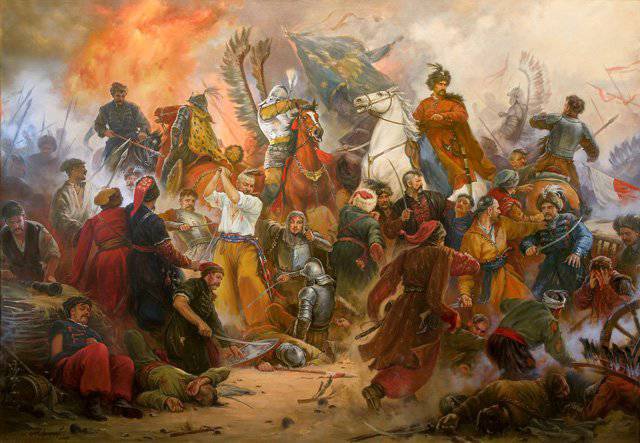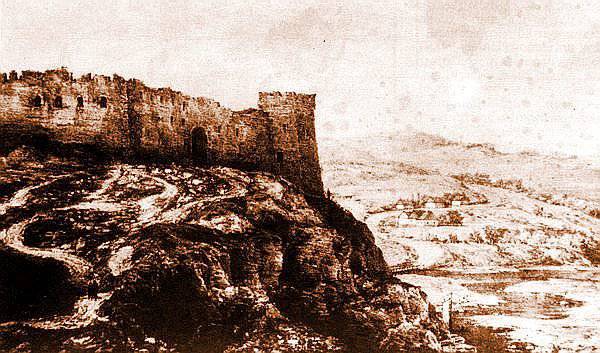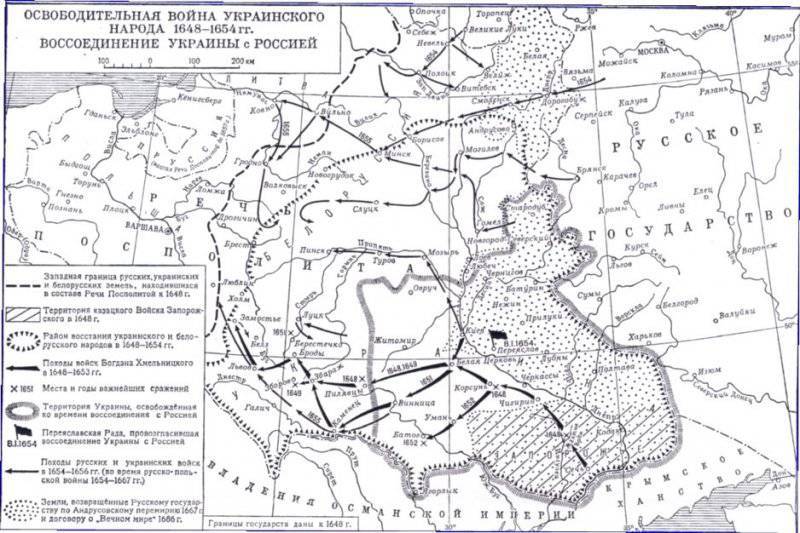War of Independence and the Battle of Zhvants
The prehistory of the uprising and the war of liberation 1648-1654
The Lublin Seym 1569 of the year led to the formation of the Polish-Lithuanian Commonwealth - a federation of two states (the Grand Duchy of Lithuania and Poland). Thus, the Russian (Ukrainian) lands that were part of the Grand Duchy of Lithuania came under the jurisdiction of the Polish king and gentry. The population of Ukraine, most of whom were peasants, came under the yoke of magnates, gentry (nobles) and Jews. Jews played the role of governors, since the Polish gentry were not interested in economic affairs. By their activity, including the usury, the Jews caused the hatred of the whole nation (therefore, they were completely killed during the riots). The peasants were enslaved and worked on the 4-6 hosts days a week. Many peasants fell into such poverty that their position could be compared with slave. Quite a large urban population was also subjected to strong pressure in the form of taxes, levies and natural duties.
From 1596, when the political union of Lublin was supplemented by a church union, economic oppression was supplemented by religious. The local Orthodox Church was supposed to submit to the Catholic Church, the Vatican. All this was aggravated by the national arrogance of the Polish gentry, which was contemptuous of the culture and traditions of the broad masses of the people. To become part of the elite of the Commonwealth, the Little Russians needed to renounce their faith, Russianness, and become Lyakh.
At the same time in the Dnieper went the formation of an autonomous region - Zaporizhzhya Sich. In an effort to free themselves from the power of the nobility, the border elders, people went into the steppe and created their settlements, the Cossack nests — small towns, abutments (Sich). Zaporozhye (the coast below the Dnieper rapids) was protected from the sea, where the Turks could have been hit with floods, bogs and reeds, and because of its remoteness was difficult for the Polish and Lithuanian authorities. Free people (Cossacks) hunted by hunting, fishing, beekeeping, made raids against steppe inhabitants and Turks. By 1590, the Cossack army numbered about 20 thousand people. The authorities of the Commonwealth tried to subjugate the Cossacks, to attract the most prosperous part of the public service, to use the Cossacks in the campaigns and the protection of frontiers. In 1590, the beginning was the beginning of the registered Cossacks (recorded in special lists-registers): one thousand Cossacks were recruited and located on the Dnieper to protect the border. For service, the Cossacks received a salary, uniforms, were exempted from the applicants and duties. In the future, the number of registered Cossacks was expanded, but the Polish authorities constantly sought to limit the number of Cossacks and their rights, which caused their irritation.
Economic, national and religious oppression led to a wave of uprisings that were becoming more and more dangerous. The Poles brutally crushed revolts and revolts, but were never able to form a general imperial ideology and program that would suit the majority, equalizing the rights of Catholics and Orthodox, Russians and Poles. This ultimately destroyed the Polish imperial project. In 1590-1596 there was an uprising led by Kosinsky, and after his death Loboda and Nalyvayko. In 1625, the Cossacks rose under the command of Hetman Zhmailo. The Cossack Registry was reduced to 6 thousand Cossacks, although at that time there were up to 40 thousand people.
In 1630, he raised an uprising by the hetman of Zaporozhye Cossacks spawning Taras Fedorovich. The uprising covered a large territory of Ukraine, and after stubborn fighting the Polish hetman Stanislav Konetspolsky was forced to cede and conclude the Pereyaslav agreement 1630 of the year. According to it, the Cossack registry increased from 6 to 8 thousand people. In 1635, an uprising began under the command of hetman Ivan Sulima. It was cruelly crushed.
In 1637, an uprising began under the leadership of the hetman of the unregistered Zaporizhzhya Cossacks Pavlyuk. The uprising swept large areas. Pavlyuk was a supporter of unification with the Don Cossacks and the transition to citizenship of the Russian Kingdom. The uprising was drowned in blood. Nikolai Pototsky arranged mass terror, whole roads were lined with stakes with Cossacks and peasants planted on them.
In 1638, a new uprising began. He was headed by the hetman of the non-registering Zaporizhzhya Cossacks Yakov Ostryanin, and after his departure to the territory of Sloboda Ukraine, under the protection of Moscow, hetman Dmitry Gunya. The uprising was crushed, they carried out a ruthless massacre on its members.
The defeat of the anti-Polish uprisings led to a deterioration in the situation of the local population. The Poles committed atrocities, and the situation worsened not only for ordinary Cossacks and peasants, but also for registered Cossacks. In 1638, the Polish Sejm abolished the position of hetman, the election of the captains and colonels. Now the registered Cossacks were ruled by a commissioner who was appointed by the Sejm. Registered Cossacks pledged to suppress any actions against the Polish crown. The terror and “tightening the screws” temporarily calmed down the situation: 10 years of “golden peace” came. However, it was a lull before a terrible storm. The Polish authorities were unable or unwilling to resolve the fundamental contradictions. The oppression only intensified. Representatives of the Orthodox population were practically excluded even from the middle echelons of the local administration.
In 1648, a rebellion of Cossacks of the Zaporizhzhya Sich began, which led the hetman of the lower-level Zaporozhye Cossacks and the Colonel of the Zaporizhzhya Troops Bogdan Khmelnitsky. The uprising quickly spread through the territory of the Left-Bank and Right-Bank Ukraine, White Russia, Volyn and Podolia, turning into the Liberation War. The war of Khmelnitsky’s army with the Polish Crown went on with varying success. Khmelnitsky was able to attract the Crimean Khanate to this war. 6 May 1648, the Cossacks under the Yellow Waters were able to win their first major victory, destroying the advanced forces of Stefan Potocki. Registered Cossacks in the Polish service went over to the rebels. Then in the battle of Korsun 15-16 (25-26) in May 1648, the Cossacks and the Crimean Tatars completely defeated the main Polish forces. Both Polish coroner hetman Nikolay Pototsky and Martin Kalinowski were taken prisoner.
The first victories of the Cossacks cleared the way and caused a mass uprising. In addition, King Vladislav IV died in May in Warsaw, the period of "interregnum" began. The Poles could not gather an army. Throughout the summer of 1648, the rebels and Tatars continued to liberate the territories from the Polish presence. It must be said that the Crimean Tatars plundered everyone and hijacked not only Poles, but also Little Russia Russians. The Khmelnitsky army knocked out the Poles from the Left Bank, and then occupied three right-bank voivodships: the Bratslav, Kiev and Podolsk. The uprising was accompanied by the massacre of Poles and Jews, all those who did not have time to escape were destroyed.
In September, 1648, in the battle of Pilyavtsy, the rebels destroyed another Polish army. The Khmelnytsky army laid siege to Lviv and Zamostya, but the fatigue of the troops, the plague epidemic, disagreements with the Tatars did not allow them to take these strong fortresses. From the inhabitants of the cities they took large contributions and withdrew. In addition, the Cossack officers wanted to negotiate with the Polish crown, she also feared the deployment of a peasant war. Negotiations began with the government of the new king, Jan Casimir. Negotiations were without any results. Khmelnitsky has achieved great success and did not want to give in. And the Poles could not fulfill his requirements. In addition, the Thirty Years War ended in Europe at this time, thousands of mercenaries remained idle. Warsaw strongly strengthened the army at the expense of German, Swedish and Italian mercenaries.
Khmelnitsky prevented the unification of the army of the Polish king with the forces of Vishnevetsky and other magnates from Zbarazh. In June, 1649, Khmelnitsky was able to overturn the Polish army and forced him to take refuge in Zbarazh. Constant shelling and assault, lack of food exhausted the Polish forces. The Polish king could not speak immediately, the militia gathered slowly. Only when the army grew to 30 thousand people, it slowly moved through Lviv to Zborov. Khmelnitsky, leaving the infantry under Zbarazh, spoke out to meet the king. 5-6 (15-16) August Zborovsky battle. The beginning of the battle was successful. Taking advantage of the carelessness of the enemy and the lack of military intelligence, the Cossacks and Tatars struck a sudden blow and destroyed several thousand enemies. The main forces of the Polish army were also on the verge of defeat. The Polish army could not stand the impact of Khmelnitsky troops, and the Poles took refuge in the train, began to strengthen it with trenches. Shortage of people and provisions did not give hope for holding positions. Attacks Cossacks became increasingly fierce. The situation was critical. The Polish Military Council promised the Crimean Khan everything that he wished if the Crimean troops retreated from Khmelnitsky. Early in the morning of August 6 the fight would be resumed. Cossacks were already on the shaft, when he changed the Crimean Khan. Islyam III. Giray agreed to the terms of the king: he was promised a large sum, allowed to take full and plunder Russian (Ukrainian) lands on the way to Crimea.
Thus, the Crimean Tatars saved the Polish army from complete annihilation. Khmelnitsky could not simultaneously confront the Poles and Tatars, and under the pressure of the Crimean Khan stopped the battle and went to negotiate. 8 August 1649 was signed Zborovsky peace. The southeastern territories of the Polish-Lithuanian Commonwealth (Hetmanate) gained autonomy, Chigirin became its capital. The sole ruler of the Zaporozhian Army was the elected hetman. The registry increased to 40 thousand Cossacks. The territory of autonomy was freed from Jews and Jesuits. The Polish authorities promised amnesty to all participants in the uprising. All posts and ranks in the Kiev, Bratslav, and Chernigov provinces could only be received by local Orthodox nobles. The Polish government pledged to destroy the union, restoring the rights of the Orthodox clergy. Kiev Metropolitan was to enter the Senate.
However, this world could not be durable. He, in fact, was only a truce. Both sides understood that the war would continue. The Polish elite could not accept the idea of the autonomy of a part of Ukraine, the equality of the Orthodox Church with the Catholic Church and the creation of the 40-thousand. Cossack army. Polish nobles wanted revenge, take revenge for defeat. The extraordinary Seym approved the agreement, but the union was not destroyed, the Metropolitan of Kiev was not allowed into the Senate. Poland was actively preparing for a new military campaign. Poland gathered a large army, only mercenaries were up to 20 thousand soldiers. Discontent agreement was expressed in Ukraine. Many believed that it was necessary to continue the offensive, tearing out more serious concessions. Many Cossacks were not included in the registry. Almost nothing from the agreement did not win the peasants. A Russian messenger from Poland wrote to Moscow: “And there came flakes to Bogdan de Khmelnitsky, gathered more 50 000 people, and wanted to kill him: for which he reconciled with the king without our advice”.

Berestetskaya battle.
In December, the Diet of 1651 approved a new punitive campaign. At the beginning of 1651, the Polish army moved to Bratslavshchina, then to Vinnitsa. The parties exchanged blows. Red had defeated the regiment of Nechay. At Vinnitsa, the Bogun regiment defeated cavalry magnate Kalinowski. Khmelnitsky gathered a rad and raised the question of war or peace (negotiations with the king). Rada spoke in favor of a decisive struggle until complete victory. 18 (28) June - 30 June (10 July) 1651, a decisive battle took place near the village of Berestechko. The outcome of the battle predetermined another betrayal of the Crimean Tatars: Khan Islam-Girey fled. What was the cause of the flight is not known - bribing by the Poles or simply the fear of defeat. During the departure, Khan detained and took Khmelnitsky with him. The Cossacks, left without a hetman, went on the defensive in a fortified camp. They chose the new hetman Bohun. June 30 (July 10) during an unsuccessful counterattack, the Cossack army was defeated and suffered heavy losses.
However, this victory did not lead to the defeat of the Khmelnitsky army. The hetman did not lose heart and quickly assembled a new army. In the rear of the Polish-Lithuanian troops guerrilla war broke out, it was difficult to get food in the devastated area. The Poles did not dare to continue the offensive and began negotiations. 18 (28) September 1651 was concluded Belotserkovsky peace. The number of registered Cossacks was reduced to 20 thousand people, the Cossacks were supposed to live only in the Kiev province. In general, the conditions put the Cossacks in almost the same position as they were before 1648. Therefore, both sides were dissatisfied and were preparing to continue the war. During this period, the Russian government actively assisted Khmelnitsky by sending money, gunpowder and lead. In addition, Khmelnitsky restored the alliance with the Crimean Khan.
Battle of Zhvanets
In April 1652, the Cossack officers resumed the war. 1-2 June 1652 of the year in the battle of Batog 20-thousand was destroyed. Polish army under the command of Martin Kalinowski. In March, Ivan Bohun on Right Bank Ukraine defeated the forces of the Polish gentry, led by magnate Charnetsky.
Bogdan Khmelnitsky and the Crimean Khan, combining their forces, began an offensive in the direction of Kamyanets-Podilsky. Here was located a large army of the Polish king Jan Casimir. The Polish king was waiting for news of the fall of Suceava, after which the Wallachian and Hungarian commanders were to come forward. From Kamyanets, Polish troops moved to Bar. Having received news of the unification of the troops of the Crimean Khan with the Cossacks, the Polish Military Council decided to retreat to the Zhvanets area, become a fortified camp there and wait for the Allied approach. At the Zhvanetsky castle, between the Dniester and Zhvanchik rivers, the Polish army built a fortified camp. A bridge was built across the Dniester to communicate with Bukowina. However, after a two-month siege near Suceava a truce was concluded. The heavy losses and fatigue of the troops led to the fact that only a small detachment was sent to help the Poles.

Zhvanetsky castle.
Given the difficult situation of the Polish army, Khmelnitsky decided to limit himself to the siege of the enemy camp. In October, the Cossacks and Tatars blocked the Polish army under Zhvanets. Khmelnitsky troops occupied the neighboring towns of Podolsk. Separate Polish detachments that tried to help the main forces and collect provisions were defeated. Cossack detachments carried out raids on Galicia and Volyn. Polish troops lacked food, fodder, firewood, warm clothes, the situation was aggravated by the cold. The mass desertion of the gentry and internal unrest undermined the combat capability of the army. The siege lasted 2 month. The case, as during the Zborowski battle, went to the complete defeat of the Polish army. In the royal camp ended food and ammunition, epidemics broke out. The only hope of the highest Polish command remained negotiations with the Crimean Tatars.
The situation was again saved by the Crimean Khan. Khmelnitsky, who calculated everything correctly and saw that the Polish troops were demoralized and a moment of decisive action had come, offered the Khan a decisive blow. However, the Crimean Tatars left their allies in December and left. Islam Girey, in the light of the stalemate of the Polish army, decided not to allow its complete defeat. Crimean feudal lords gladly participated in this war, the robbery of settlements and the withdrawal of people for sale into slavery greatly enriched them. In addition, the Crimean troops tried to avoid serious clashes. They waited - whose will take. If the Cossacks won, they joined. The Crimean Khan did not want a decisive victory of the Cossacks or the entry of Ukraine into the Russian kingdom, as this complicated the situation of the Crimea. The best scenario for the Crimean Tatars is a long slaughter and civil strife, when it is possible to take people with impunity for sale into slavery and plunder the land. The Polish king promised to pay the Crimean Khan a contribution in 100 of thousands of zlotys and gave permission for the 40 days to rob and steal the Russian population in Volyn into slavery (yasyr).
Khmelnitsky had to agree to the restoration of the conditions of the Zborovsky agreement of 1649 of the year and the abolition of the unprofitable Cossacks of the Belotserkovsky agreement of 1651 of the year. The agreement was acceptable, but did not solve the problem fundamentally. The Ukrainian hetman again failed to destroy the Polish army and capture King Jan Casimir.
Once again, devoted to the Crimean Tatars, Khmelnitsky understood that it was impossible to rely on the Crimean Khanate. To prevent the threat of a new Polish invasion was possible only with the help of the Russian kingdom. Therefore, Bogdan Khmelnitsky increasingly insistently began to pursue a policy of reunification of Ukraine with Russia. The Cossack army demanded to break the alliance with the Crimean Khan and reunite Ukraine with Russia. In January, 1654 in Pereyaslav entered into an agreement by which Ukraine was reunited with Russia. Cossack officers received from Moscow those rights that she so unsuccessfully tried to wrest from the Polish crown. Peasants and Cossacks of Ukraine were freed from national and religious oppression. A fierce Russian-Polish war began.

Information